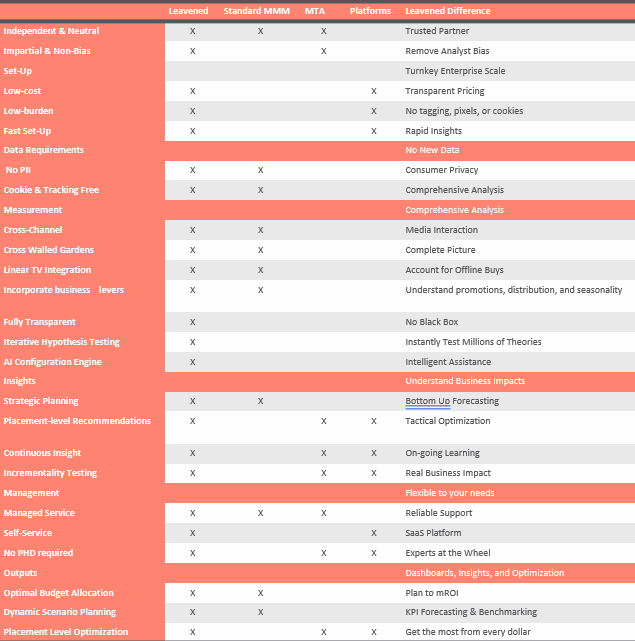What are the advantages and disadvantages of Marketing Mix Modeling vs. multi-touch attribution? It’s a common question — and one that requires a bit of an in-depth answer.
With so many channels available in the modern marketing world, agencies need powerful and sophisticated tools to help them pinpoint where customers are and which channels or a mix of channels generate the most conversions and the biggest return on investment (ROI).
Both approaches can uncover business insights but tackle the problem very differently. MMM solutions are a top-down perspective of every aspect of a business and attempt to understand how each aspect contributes to a business outcome. MTA is a bottom-up approach, attempting to meticulously measure every consumer exposure to media and then attribute each exposure to a website visit or online sale.
MTA solutions are great for primarily digital brands, have access to most consumer media touchpoints, and the ability to match a sale to a single consumer. MMM, on the other hand, is preferred by brands that only have access to aggregated sales data, rely on a healthy online and offline media mix, and wish to understand the non-media impacts on their business.
MTA solutions can provide incredible precision for digital media campaigns; however, MMMs tend to provide a more accurate, holistic perspective.
Marketing Mix Modeling
So it’s perhaps no surprise to learn that marketing mix models came well before multi-touch attribution. MMM was formulated to take stock of retail marketing initiatives and to do so at regularly spaced intervals — typically business quarters but also annually.
This leads us to the second big difference between the two approaches: The MMM approach relies on aggregate historical data rather than the real-time focus of attribution models.
Historically, MMM has assessed the Four Ps: price, product, promotion, and place. It aims to identify or tease out of the data the best combination of the four elements at driving revenue.
Both MMM and attribution modeling are utilized to gain insights into how various marketing tactics contribute to key performance indicators (KPI). Unlike multi-touch attribution, however, MMM can provide deeper and more thorough insights.
For example, modern MMM can reveal the impact of both online and offline marketing tactics while simultaneously accounting and adjusting for other variables, including broader economic indicators, business promotions, and other relevant data.
Furthermore, Marketing Mix Modeling takes into account the entire market mix and not simply addressable channels. It provides what might be called a 30,000-foot view of everything from sale info and revenue to costs and competition — along with a broad overview of how these variables interact.
The MMM process then calls for regression analyses designed to reveal how any combination of variables acts on one another. The resulting data can be charted to illustrate relationships between these marketing variables.
Thus we can say that MMM excels at providing illustrative data that reveals how every marketing initiative affects the bottom line.
It is limited, however, in its ability to obtain more real-time, granular insights, which is where attribution modeling comes in.
Multi-Touch Attribution
Attribution modeling traces the customer journey across a digital landscape (online marketing and sales). It provides insights into consumer behavior by revealing touchpoints of engagement. Those touchpoints add up to trends toward conversions.
The main advantage of this technique is that it allows for real-time assessments. And with the digital world continuing to grow and reshape itself with that growth, touch attribution is in many ways perfectly positioned to allow for the granular tracking and analysis of consumer behavior.
To achieve the kind of results that inform marketing efforts going forward, attribution models come in a variety of flavors: first interaction, last interaction, linear attribution, time decay attribution, and more.
However, with the advantage of real-time analysis comes the simultaneous disadvantage of the complexity of the algorithms harnessed to the data. There can be lots of trial and error before settling on the best method of tracking a particular set of variables.
Additionally, MTA requires extensive consumer tracking and can be difficult to measure across walled gardens and offline. Although there have been advancements in TV tracking, many of these are costly and only measure a fraction of the total market.

The Leavened Approach
Leavened’s immense power and scope derive from the Leavened Iterative Hypothesis Testing (IHT) Engine, enabling a more thorough — and thoroughly objective — testing of marketing hypotheses at dazzling speeds.
Rather than just marking a user’s progress toward a web conversion — as is the case with multi-touch attribution — or aggregating data using a quarterly or biannual approach, Leavened reveals much more.
It can show how marketing initiatives attract leads across different media and how those insights can fuel revenue growth for future marketing campaigns by informing agencies how best to optimize investment levels for different media types.
Additionally, the IHT provides an inexpensive MMM solution that is available to many brands that previously have never considered MMMs because of the historic high price point.
These are significant differences that, over time, enable agencies to gain access to a much richer and more robust data set. It means Leavened’s approach is superior to multi-touch attribution and MMM.